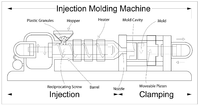
Photo from wikipedia
Microinjection molding is a novel frontier polymer processing strategy different from conventional ones. In this paper, three different cavity-sizes of micro-mold tools were firstly fabricated, and the influences of micro-mold… Click to show full abstract
Microinjection molding is a novel frontier polymer processing strategy different from conventional ones. In this paper, three different cavity-sizes of micro-mold tools were firstly fabricated, and the influences of micro-mold cavity dimension on the phase morphology structure, crystallization and orientation, and mechanical performance of the microinjection molded polylactic acid (PLA)/polycaprolactone (PCL) blend microparts were carefully investigated accordingly. The results show that the reduction of the cavity size would result in much higher shear stress field and cooling temperature gradient, which is advantageous to the fibrillation and orientation of PCL-dispersed phase. Consequently, with decreasing the micro-mold cavity dimension from length 26 mm to 15 mm, the interfacial compatibility is improved, significantly increasing number of PCL fibers with smaller diameter are in situ formed in PLA matrix and their orientation degree also obviously increases, which is verified by SEM and 2D-WAXD measurements. The Differential Scanning Calorimetry (DSC) analysis shows that the decrease in cavity dimension causes the enhancement of PLA crystallization property due to shear-induced crystallization, which is reflected by the decreasing PLA cold crystallization temperature and increasing PLA crystallinity (almost doubling that of conventional macropart). As a result, the dynamic/static mechanical property measurements exhibit that with decreasing the cavity size, the storage modulus, and the loss modulus of PLA/PCL blend micropart increase, and the corresponding tensile strength, elongation at break, and Young’s modulus also present an obviously increasing tendency. The related investigations would provide some new spaces and insights for realization of high-performance of PLA/PCL blend micropart.
Journal Title: Polymers
Year Published: 2021
Link to full text (if available)
Share on Social Media: Sign Up to like & get
recommendations!